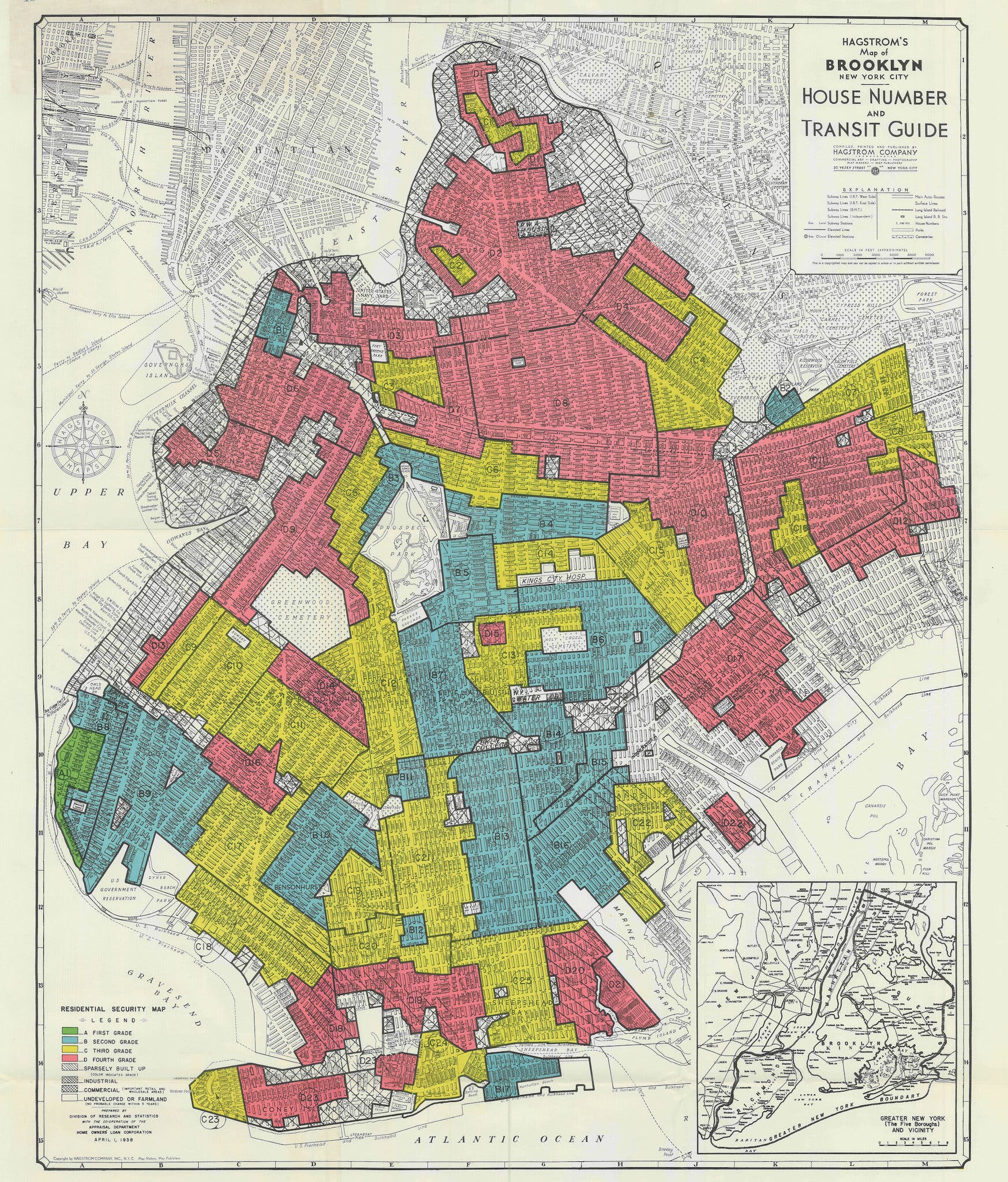 |
|
This 1938 map of Brooklyn shows areas marked off in red being rated at the lowest level of suitability for mortgage loans by the federal Home Owners Loan Corp.; the ensuing neglect of such neighborhoods perpetuated decline in many measures of quality of life. Today, such areas are associated with higher proportions of people living with visual impairment and blindness. Photo: National Archives and Records Administration. Click image to enlarge. |
Redlining was a discriminatory housing policy in the United States enacted in 1933 that denoted neighborhoods with high proportions of Black individuals as “undesirable,” with a presumption of high risk of mortgage defaults; realtors also discouraged residents there from purchasing homes in more desirable areas. As a result, home purchasing—and the accumulation of wealth than can accompany it—was much harder in these communities. Although redlining became illegal in 1968, previously redlined communities feel the health implications of this discriminatory policy to this day. In a recent study, researchers investigated rates of visual impairment and blindness from 2010 in neighborhoods that were graded for redlining.
A total of 11,668 census tracts were analyzed, and those with worse redlining scores had increased odds of residents self-reporting visual impairment and blindness.
“High prevalence of visual impairment increases the risk for multitudes of clinically important sequelae, such as poor mental health, increased social isolation, risk of falls, injuries and serious fractures,” the authors noted in their paper for the Ophthalmology journal.
How can policies that began 90 years ago affect the visual status of citizens today? Redlining discourages investment in infrastructure and other public resources that normally sustain a community. Redlined neighborhoods also receive disproportionately higher rates of toxic waste dumping, creating greater environmental exposure. The resulting urban blight then becomes self-sustaining: having proven itself undesirable, the neighborhood becomes further isolated and underfunded by both public and private investors.
“Access to reliable transportation, healthy foods, green spaces, employment, education, preventative healthcare, and clean air and water can influence a person’s lifestyle, overall health and eye health,” the authors explain. “For example, if an individual has diabetes but, because they live in a historically redlined neighborhood, the neighborhood has fewer resources such as less access to healthy foods and safe green spaces for exercise, it is easier for diabetes to become uncontrolled, which can lead to diabetic retinopathy and vision loss.”
Individuals with vision impairment are more likely to have restricted mobility and restricted independence, requiring additional accommodations. However, census tracts with worse redlining scores may not have the needed resources, the authors explained. For example, if an individual is unable to drive, they may not have the option to walk or use public transportation in redlined neighborhoods.
“This is due to decades of divestment from redlined areas, leaving sidewalks in disrepair with poor lighting, curbs without curb-cuts and a lack of voice-enabled crosswalks and ramps for wheelchairs or walkers,” the authors explained. “Additionally, public transportation, which provides an important source of mobility and independence for many visually impaired people, is poorly funded and poorly available in locations across the United States, including previously redlined neighborhoods. In other words, areas with the highest visual impairment and blindness prevalence may paradoxically have fewer resources.”
Understanding how neighborhood segregation impacts eye health is important for planning improved mechanisms of eyecare delivery to mitigate health disparities.
“Policy change is essential to ensuring that census tracts with worse spatialized residential segregation and neighborhoods with higher proportions of visual impairment and blindness have the necessary resources to carry out interventions to mitigate preventable visual impairment and blindness,” the authors concluded. “These policies could include addressing such issues that disproportionately affect redlined neighborhoods including elevated levels of environmental pollutants, lack of green spaces, limited access to transportation for eye appointments and access to quality preventative eyecare services.”
Hicks PM, Woodward MA, Niziol LM, et al. The association of redlining with visual impairment and blindness. Ophthalmology. December 5, 2022. [Epub ahead of print]. |


